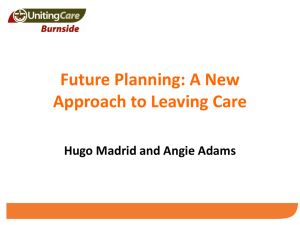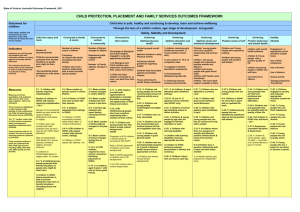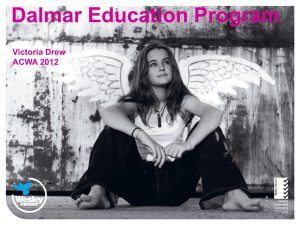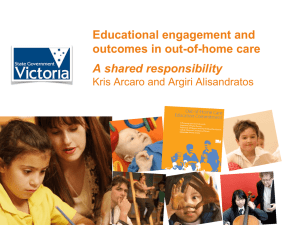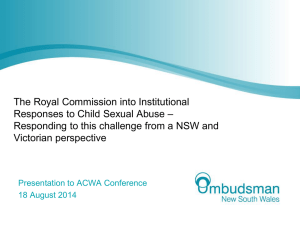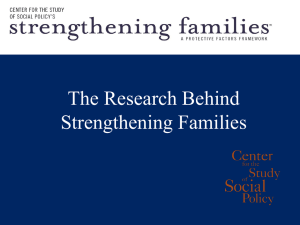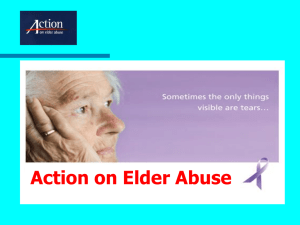Research
advertisement
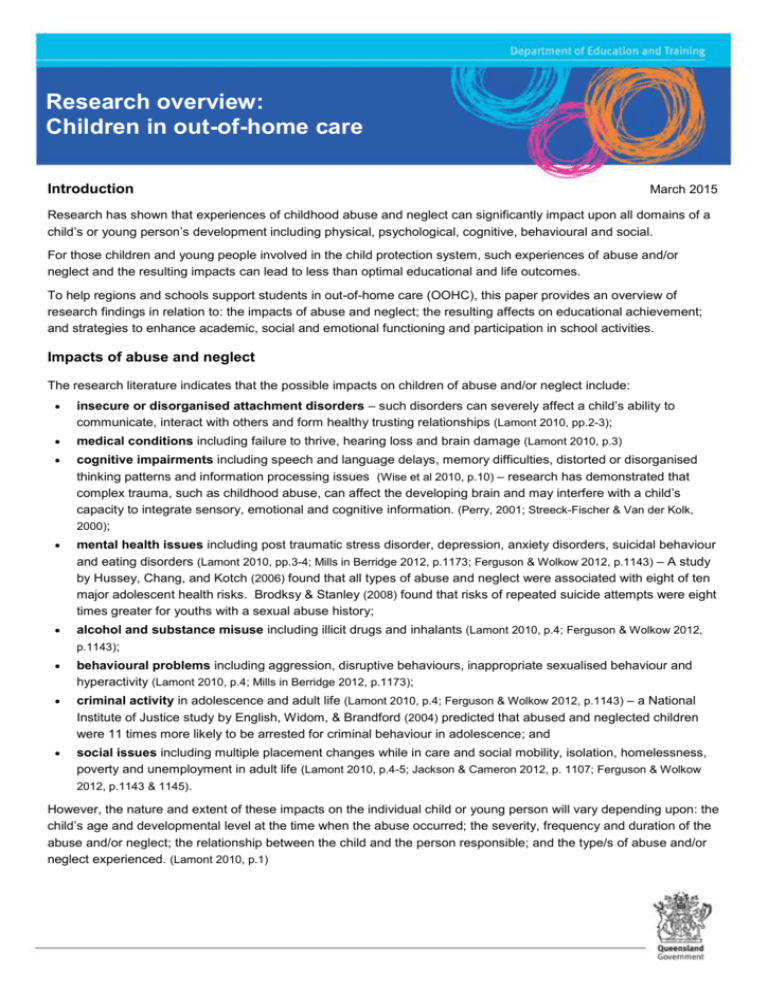
Research overview: Children in out-of-home care Introduction March 2015 Research has shown that experiences of childhood abuse and neglect can significantly impact upon all domains of a child’s or young person’s development including physical, psychological, cognitive, behavioural and social. For those children and young people involved in the child protection system, such experiences of abuse and/or neglect and the resulting impacts can lead to less than optimal educational and life outcomes. To help regions and schools support students in out-of-home care (OOHC), this paper provides an overview of research findings in relation to: the impacts of abuse and neglect; the resulting affects on educational achievement; and strategies to enhance academic, social and emotional functioning and participation in school activities. Impacts of abuse and neglect The research literature indicates that the possible impacts on children of abuse and/or neglect include: insecure or disorganised attachment disorders – such disorders can severely affect a child’s ability to communicate, interact with others and form healthy trusting relationships (Lamont 2010, pp.2-3); medical conditions including failure to thrive, hearing loss and brain damage (Lamont 2010, p.3) cognitive impairments including speech and language delays, memory difficulties, distorted or disorganised thinking patterns and information processing issues (Wise et al 2010, p.10) – research has demonstrated that complex trauma, such as childhood abuse, can affect the developing brain and may interfere with a child’s capacity to integrate sensory, emotional and cognitive information. (Perry, 2001; Streeck-Fischer & Van der Kolk, 2000); mental health issues including post traumatic stress disorder, depression, anxiety disorders, suicidal behaviour and eating disorders (Lamont 2010, pp.3-4; Mills in Berridge 2012, p.1173; Ferguson & Wolkow 2012, p.1143) – A study by Hussey, Chang, and Kotch (2006) found that all types of abuse and neglect were associated with eight of ten major adolescent health risks. Brodksy & Stanley (2008) found that risks of repeated suicide attempts were eight times greater for youths with a sexual abuse history; alcohol and substance misuse including illicit drugs and inhalants (Lamont 2010, p.4; Ferguson & Wolkow 2012, p.1143); behavioural problems including aggression, disruptive behaviours, inappropriate sexualised behaviour and hyperactivity (Lamont 2010, p.4; Mills in Berridge 2012, p.1173); criminal activity in adolescence and adult life (Lamont 2010, p.4; Ferguson & Wolkow 2012, p.1143) – a National Institute of Justice study by English, Widom, & Brandford (2004) predicted that abused and neglected children were 11 times more likely to be arrested for criminal behaviour in adolescence; and social issues including multiple placement changes while in care and social mobility, isolation, homelessness, poverty and unemployment in adult life (Lamont 2010, p.4-5; Jackson & Cameron 2012, p. 1107; Ferguson & Wolkow 2012, p.1143 & 1145). However, the nature and extent of these impacts on the individual child or young person will vary depending upon: the child’s age and developmental level at the time when the abuse occurred; the severity, frequency and duration of the abuse and/or neglect; the relationship between the child and the person responsible; and the type/s of abuse and/or neglect experienced. (Lamont 2010, p.1) Impacts of abuse and trauma on educational achievement Australian and international research has also shown that such experiences of abuse and/or neglect and the resulting impacts on the child’s functioning will, in turn, influence the child’s academic performance and participation in the school environment. Impacts that have been demonstrated in research include: standardised tests – research has shown that students in OOHC frequently score significantly lower on standardised tests than their same-age peers (Cheung et al 2012, p.1092; Forsman & Vinnerljung 2012, p. 1084; Harper & Schmidt 2012, p. 1176-7; Flynn et al 2012, p. 1183; Ferguson & Wolkow 2012, p. 1143-5); grade level performance –students in OOHC frequently perform below the grade level when compared to their peers (Cheung et al 2012, p.1092; Harper & Schmidt 2012, p. 1176-7; Ferguson & Wolkow 2012, p. 1144) – Flynn et al (2012, p. 1183) indicated in their research that studies have consistently shown that, in both primary and secondary school, many students in OOHC lag one or two years behind their peers in the general population; repeating a year level – research has shown that students in OOHC were more likely to repeat a year level (Flynn et al 2012, p. 1184; Wise et al 2010, p.7) – Ferguson & Wolkow (2012 p.1144) found that twice as many students in care repeated a grade when compared with their peers not in OOHC; school changes – research indicates that many students in OOHC experience multiple school changes during the course of their education than students not in OOHC (Jackson & Cameron 2012, p. 1111; Wise et al 2010, p.7; Flynn et al 2012, p. 1184); learning disabilities and special education – when compared with same-age peers students in OOHC report higher rates of learning disabilities and may also require more remedial assistance and special education placements (Cheung et al 2012, p.1092; Harper & Schmidt 2012, p. 1176-7; Flynn et al 2012, p. 1183) – students in OOHC are five times more likely to receive special education services than their peers. (Ferguson & Wolkow 2012, p. 1144); behavioural issues and school abscences – research has shown that students in OOHC exhibit more behaviour problems in school and experience much higher rates of suspensions, exclusions and school absences when compared to same-age peers (Cheung et al 2012, p.1092; Harper & Schmidt 2012, p. 1176-7; Flynn et al 2012, p. 1183; Ferguson & Wolkow 2012, p. 1144-5; Wise et al 2010, p.7); academic milestones – when compared to same-age peers, research has shown that students in OOHC often fail to meet appropriate academic milestones (Cheung et al 2012, p.1092; Harper & Schmidt 2012, p. 1176-7); and post-secondary education – according to current research, students in OOHC frequently do not complete high school or undertake post-secondary education (Forsman & Vinnerljung 2012, p. 1084; Johansson & Hojer 2012, p.1136; Harper & Schmidt 2012, p. 1176-7; Flynn et al 2012, p. 1183; Ferguson & Wolkow 2012, p. 1144-5). Strategies to enhance individual student achievement and participation Given this evidence, it is clear that students in OOHC can face multiple complex challenges during their lives. However, as Sir Paul Ennals, Chief Executive United Kingdom National Children’s Bureau, highlighted in 20091 “good schools can be the key to their success. School can provide the stability they need, a safe place in a turbulent world, an opportunity to excel, and a route map out of their difficulties into a more positive future.” The research literature also provides guidance about positive strategies that can be implemented to better support students in OOHC. 1 Quoted in the Department for Children, Schools and Families UK resource Improving the attainment of looked after children in primary schools, p.4 School buddy/mentor – Trout et al (2012, p.1116) identified in their research that a school mentor could talk with the students on a weekly basis and then facilitate connections between the students, carers 2, teachers and school leadership, advocate for the students and monitor indicators of school engagement. Identify a key staff member within the school who can act as a buddy/mentor for each student in OOHC. This person could make regular contact with the student and provide additional support in raising and addressing their needs. Where a school has a number of students in OOHC, consider whether the same person may take on this role for multiple students – this could help to identify common needs and to ensure consistency in planning and provision of support. High expectations – Research has shown that higher expectations in relation to education and learning are significantly associated with higher levels of academic achievement for students in OOHC. (Berridge 2012, p.1174; Cheung et al 2012, p.1094 & 1097-9; Gharabaghi 2012, p. 1133; Jackson & Cameron 2012, p.1113; Johansson & Hojer 2012, p.1141; Stoddart 2012, p.1157; Ferguson & Wolkow 2012, p. 1146; Wise et al 2010, p.7 & 27) Students, teachers, carers and Child Safety Officers (CSOs) should: have high expectations for the student’s education and learning; set goals and targets that lead to improved achievement and participation; and acknowledge success when goals are achieved. Goals and targets should be reflected in the student’s Education Support Plan (ESP) and Senior Education and Training (SET) plan. Home-based involvement in education and learning – Research has repeatedly shown that parent or carer home-based involvement in education and learning, such as helping with homework and providing homebased tutoring, and creation of a literacy environment3 in the carer’s home were significantly associated with academic success for students in OOHC. (Cheung et al 2012, p.1093-4 & 1097-8; Gharabaghi 2012, p. 1130-1 & 1133; Griffiths 2012, p. 1101-2; Harper & Schmidt 2012, p. 1180-1; Forsman & Vinnerljung 2012, p. 1086-8; Flynn et al 2012, p. 1187-9; Trout 2012, p. 1117) Try to communicate regularly with carers. Talk with carers about how they could provide extra educational support to students in their care. For example, encourage them to: talk with the student about their progress at school; read at night with the student; help with homework; provide some one-on-one tutoring, if appropriate; take the student to the library or provide the student with reading material eg books, newspapers, magazines, comics; or do one extra activity with the student each week which is provided by the teacher and reinforces some area of the curriculum covered in the classroom that week. Stable home and school environment – Research indicates that children in a consistent and stable environment, which allows them to develop relationships, stay in the same school, and manage learning disability, have a much greater probability of successfully completing secondary school. (Pecora 2012, p.1124-7; Jackson & Cameron 2012, p. 1111; Johansson & Hojer 2012, p.1139; Stoddart 2012, p.1157; Wise et al 2010, p.27) Work in partnership with CSOs and try to minimise disruptions to school attendance for students in OOHC. For example: let the CSO know about any issues that may impact on the student’s placement or school status so they can intervene early and minimise disruptions; work with the CSO to find ways to keep the student in their current school when there is placement instability; and work with the CSO to respond to behavioural issues before they lead to school disciplinary abscences. Post-secondary education – Research on participation in post-secondary education (PSE) indicates that if a child is taught to value PSE, is prepared academically and otherwise for PSE and wishes to attend PSE, there is a high probability that the child will participate in PSE and the associated costs won’t stand in the way – bring a ‘culture’ of PSE into their lives so that it becomes a real, viable opportunity for them. (Finnie 2012, p. 1162-3; Pecora 2012, p.1128) 2 Carers may include Child Safety approved foster or kinship carers or care staff from licensed residential care or therapeutic residential care services. 3 Creating a literacy environment is defined as a situation when a parent or carer provides the student with access to books and visits to the library. (Cheung et al 2012, p.1093) Involve the student and their carer and CSO in the development of their Secondary Education and Training (SET) Plan and talk about how the student’s Child Safety Transition from Care planning4 may contribute to the student achieving their goals. To further encourage students in OOHC who have the ability and desire to undertake PSE, consider: undertaking visits to university or TAFE campuses; providing information about different pathways into PSE; providing carers with information about PSE options so that discussions with students can continue at home; developing mentoring or peer support programs; and providing assistance with application and enrolment processes. Targeted timely support – Research has shown that students in OOHC are more likely to show higher levels of academic achievement when they have: better impulse inhibition and emotional regulation, reduced externalising behaviours and higher levels of academic engagement. (Cheung et al 2012, p.1092) Where there are early indicators that a student in OOHC may have behaviour issues or difficulties coping in the classroom or school setting, work with the carer and the CSO to link the student in with support services that will help them address these issues and develop positive coping strategies. This may include accessing DETE resources, such as the Ed-LinQ mental health initiative or regional behaviour support personnel, or external resources such as the Evolve Interagency Services or other government or non-government counselling or therapeutic services. Co-ordination and communication – Research indicates that educational outcomes for students in OOHC can be negatively impacted by a lack of co-ordination, co-operation and communication between the key professionals and agencies involved with the student. (Ferguson & Wolkow 2012, p. 1146) Look for opportunities to communicate with the carer and CSO and to co-ordinate planning and service delivery. School or regional staff may be invited to participate in Child Safety planning for a student in OOHC including, but not limited to: case planning and Family Group meetings; Evolve Interagency Services meetings; Suspected Child Abuse and Neglect (SCAN) team meetings; and Residential Care Service care planning meetings. 4 The Transition from Care planning process is undertaken by the CSO as part of the case planning process with the child from the year when he or she is turning 15 years of age. Refer to the Qld Government webpage at Leaving Care for further information. Reference list Berridge D, ‘Educating young people in care: What have we learnerd?’ in Children and Youth Services Review, 34, pp.1171-1175. Brodsky B & Stanley B 2008, ‘Adverse childhood experiences and suicidal behavior’ in Psychiatric Clinics of North America, 31, pp.223–235. Cheung C, Lwin K & Jenkins JM 2012, ‘Helping youth in care succeed: Influence of caregiver involvement on academic achievement’ in Children and Youth Services Review, 34, pp.1092-1100. English D, Widom C & Brandford C 2004, ‘Another look at the effects of child abuse’ in National Institute of Justice Journal, 251, pp.23–24. Ferguson HB & Wolkow K 2012, ‘Educating children and youth in care: A review of barriers to school progress and strategies for change’ in Children and Youth Services Review, 34, pp.1143-9. Finnie R 2012, ‘Access to post-secondary education: The importance of culture’ in Children and Youth Services Review, 34, pp.1161-1170. Flynn RJ, Marquis RA, Paquet M, Peeke LM & Aubry TD 2012, ‘Effects of individual direct-instruction tutoring on foster children’s academic skills: A randomised trial’ in Children and Youth Services Review, 34, pp.1183-9. Forsman H & Vinnerljung B 2012, ‘Interventions aiming to improve school achievements of children in out-of-home care: A scoping review’ in Children and Youth Services Review, 34, pp.1084-1091. Gharabaghi K 2012, ‘Translating evidence into practice: Supporting the school performance of young people living in residential group care in Ontario’ in Children and Youth Services Review, 34, pp.1130-1134. Griffiths R 2012, ‘The Letterbox Club: An account of a postal club to raise the achievement of children aged 7 to 13 in foster care’ in Children and Youth Services Review, 34, pp.1101-6. Harper J & Schmidt F 2012, ‘Preliminary effects of a group-based tutoring program for children in long-term foster care’ in Children and Youth Services Review, 34, pp.1176-82. Hussey J, Chang J & Kotch J 2006, ‘Child maltreatment in the United States: Prevalence, risk factors, and adolescent health consequences’ in Pediatrics, 118(3), pp. 933–942. Jackson S & Cameron C 2012, ‘Leaving care: Looking ahead and aiming higher’ in Children and Youth Services Review, 34, pp.1107-1114. Johansson H &Hojer I 2012, ‘Education for disadvantaged groups – Structural and individual challenges’ in Children and Youth Services Review, 34, pp.1135-1142. Lamont A 2010, ‘Effects of child abuse and neglect for adult survivors’ Australian Institute of Family Studies(online). https://www3.aifs.gov.au/cfca/publications/effects-child-abuse-and-neglect-adult-survivors [accessed 18 March 2015]. Lamont A 2010, ‘Effects of child abuse and neglect for children and adolescents’ Australian Institute of Family Studies(online). https://www3.aifs.gov.au/cfca/publications/effects-child-abuse-and-neglect-children-and-adolesce [accessed 18 March 2015]. Pecora PJ 2012, ‘Maximizing educational achievement of youth in foster care and alumni: Factors associated with success’ in Children and Youth Services Review, 34, pp.1121-9. Perry B 2001, ‘Violence and childhood: How persisting fear can alter the developing child’s brain’ in Schetky D & Benedek E (Eds.) Text book of child and adolescent forensic psychiatry. Washington DC: American Psychiatric Press Inc. pp. 221– 238. Streeck-Fischer A & van der Kolk BA 2000, ‘Down will come baby, cradle and all: Diagnostic and therapeutic implications of chronic trauma on child development’ in Australian and New Zealand Journal of Psychiatry, 34(6), pp. 903–918. Stoddart JK 2012, ‘Using research and outcome data to improve educational services and supports for young people in care: A case study of a local children’s aid society in Ontario’ in Children and Youth Services Review, 34, pp.1154-1160. Trout AL, Tyler PM, Stewart MC & Epstein MH 2012, ‘On the Way Home: Program description and preliminary findings’ in Children and Youth Services Review, 34, pp.1115-112. Wise S, Pollack S, Mitchell G, Argus C & Farquhar P 2010, ‘Care-system Impacts on Academic Outcomes Research Report June 2010’, Anglicare Victoria and Wesley Mission Victoria.
